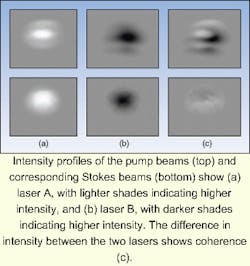Two incoherent beams become a coherent one

A recent investigation at the US Air Force Institute of Technology (AFIT; Wright-Patterson AFB, OH) and the Air Force Research Laboratory (Kirtland AFB, NM) has shown that it is possible to create a single, spatially coherent laser-beam from two mutually incoherent lasers. The technique is based on simultaneous excitation of stimulated Brillouin scattering (SBS) by two independent lasers operating at two different wavelengths in a long, multimode optical fiber. Brillouin scattering occurs spontaneously on an atomic level when light interacts with sound waves simultaneously moving through a material. Though spectrally independent, the resulting Stokes beams produce essentially the same intensity distributions corresponding to the fundamental fiber mode. The AFIT group, led by professor of engineering physics Won B. Roh, reports that there are several potential uses for the technique, including coherently combining two or more beams from a multichannel amplifier array in a master-oscillator/power-amplifier configuration.
Previous work at AFIT showed that two separate laser beams that are spatially overlapped and directed into a multimode fiber could jointly produce a single Stokes beam in the fundamental fiber mode, irrespective of the input-beam profile whenever the sum of the beam power is more than that of the SBS threshold of the fiber. The laser beams also must be within one Brillouin gain linewidth (typically about 100 MHz) of each other in frequency, but this is difficult to achieve. The AFIT group extended this case to two lasers operating at different frequencies, using the same technique to produce a Stokes beam that was not temporally coherent—a technique named incoherent beam combining (see figure). The resulting beam had a slope efficiency greater than 70%. The two resulting Stokes beams also had nearly identical spatial-intensity profiles matching the fundamental fiber mode, which is an indication that SBS in the fiber causes the spatial coherence, in spite of mutual temporal incoherence and spectral mismatch. The group proposes that the superior modal overlap in intensity that the fundamental mode shares with multimode pumping, compared to higher-order modes is responsible for the observed effect.
Incoherent combination
Incoherent beam combining can be used to scale beam power to higher levels than those achievable through coherent beam combining. If many lasers were coherently combined into a single beam, the resulting Stokes wave would reach second-order SBS threshold rapidly, resulting in decreased efficiency with increasing input power. Incoherent combining significantly reduces the limitations on the total combined power of the input beams. For the incoherent process, pump beams are different in frequency so that each pump beam builds its own Stokes beam independently.
The second-order Stokes threshold therefore is only dependent on the power in each Stokes beam, not the sum of the pump beams. Thus, the second-order Stokes threshold will be greater than that for a single coherent beam by a factor of the number of lasers being combined.
Another advantage of this technique, reports the team, is that lasers of any wavelength can be combined as long as their wavelengths lie in the transmission window of the fiber materials. This beam combining would be useful for any applications that require high brute-force laser power in a single beam such as in materials processing. It also has applications in multispectral electro-optic countermeasures or hyperspectral imaging. The spatial coherence of this technique enables the resultant focused spot or long-distance target to be diffraction-limited.
A 4.4-km length of fiber was chosen on the basis of the fiber length available on a standard spool of commercial fiber. When asked why longer fibers are preferred for beam combining, Roh explained, "The Stokes beam grows as photons are spontaneously scattered by the thermal phonons in the fiber, and hence the Stokes beam is in multimode initially. However, the Stokes photons that belong to the fundamental fiber mode are preferentially amplified as they travel up the fiber.
"In contrast," he added, "it is known that SBS generated in a short fiber (of about 1- or 2-m long) produces a phase conjugate replica of the pump beam, and that has a different set of useful applications," possibly the subject of further work at AFIT.
About the Author
Valerie Coffey-Rosich
Contributing Editor
Valerie Coffey-Rosich is a freelance science and technology writer and editor and a contributing editor for Laser Focus World; she previously served as an Associate Technical Editor (2000-2003) and a Senior Technical Editor (2007-2008) for Laser Focus World.
Valerie holds a BS in physics from the University of Nevada, Reno, and an MA in astronomy from Boston University. She specializes in editing and writing about optics, photonics, astronomy, and physics in academic, reference, and business-to-business publications. In addition to Laser Focus World, her work has appeared online and in print for clients such as the American Institute of Physics, American Heritage Dictionary, BioPhotonics, Encyclopedia Britannica, EuroPhotonics, the Optical Society of America, Photonics Focus, Photonics Spectra, Sky & Telescope, and many others. She is based in Palm Springs, California.
